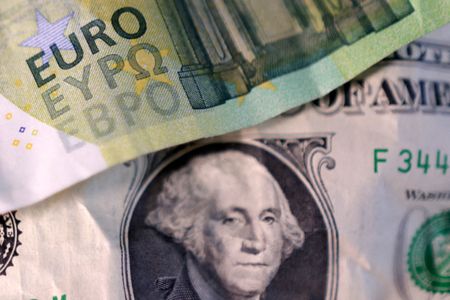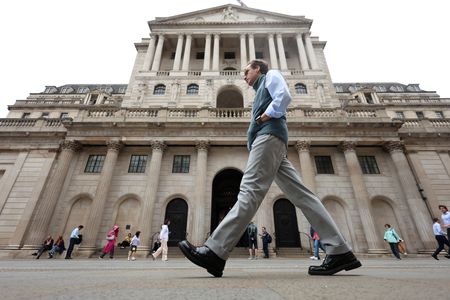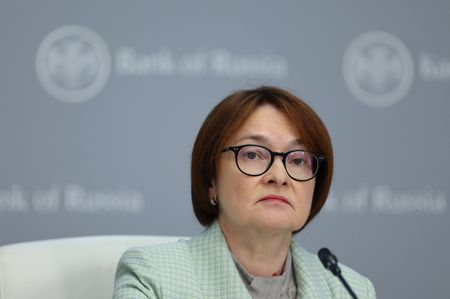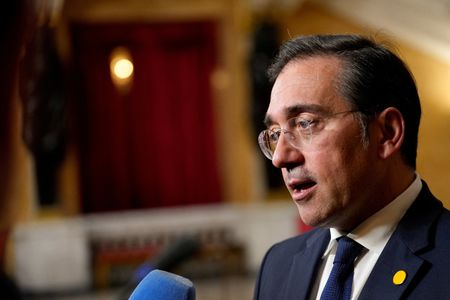By Laura Matthews
NEW YORK (Reuters) -Hedge funds and asset managers have been buying up options on foreign currencies as they look to prepare portfolios for market moves spurred by the Trump administration’s tariff policies and after a recent pullback in market expectations for currency volatility.
With Trump expected to implement new reciprocal tariff rates against major trading partners on April 2, demand for FX options, which give investors the right, but not the obligation, to buy or sell currencies at a specified rate, has jumped this year.
“If you want to speculate on … tariffs actually happening, or any big shocks to the financial system coming from the new administration, FX options and the FX markets in general are having a moment in the sun,” said Peter Vassallo, an FX portfolio manager at BNP Paribas Asset Management.
The expectation for FX volatility comes after measures of volatility have fallen since January, driven, in part, by profit taking and as tariff measures have so far undershot the markets’ worst fears. Volatility measures had risen sharply in the aftermath of Donald Trump’s victory in the U.S. election last year.
One measure of short-term volatility in the euro has fallen from a near 2-year peak touched in January, according to LSEG data, creating attractive entry points for investors looking to hedge.
The drop in volatility has slashed how much investors need to pay to open fresh options positions, either to guard their portfolios or to speculate on specific outcomes.
A three-month at-the-money EUR/USD option now costs 16% less than investors needed to pay around the inauguration, while a three-month USD/CAD option is 17% less, according to LSEG data.
With the extent of tariffs still uncertain, investors see potential risks on the horizon, making the recent cheapening in FX options a welcome relief.
“A lot of participants in the market still see a lot of potential for these tail events, which is completely understandable in the political environment,” Vassallo said, referring to risks that can trigger outsized market moves.
Volumes in over-the-counter EUR/USD options rose 104% in January to $852 billion, when compared to the corresponding period in 2024, according to data from Clarus, an ION company that researches derivatives.
Exotic strategies such as digital options and barriers – contracts that kick in once a certain price threshold is touched – more than doubled in the euro to $26 billion in January and shot up more than 2,000% for CAD to $7.3 billion, Clarus’s data showed.
At listed derivatives exchange operator CME Group, volumes rose 76% compared to the same time last year, with an average of $7 billion notional changing hands electronically every day. CME also saw record open positioning in FX options of more than 1.2 million contracts on March 5.
The increase is particularly noticeable for trade-sensitive currencies. Volume in euro options rose 105% while Canadian dollar options climbed 227%, according to CME data.
The surge is accompanied by new participants entering the market to hedge their exposure in other asset classes, or speculate and take positions, said Chris Povey, head of FX options at CME.
Investors’ preference for FX options to offset risks is also being helped by relatively lower levels of FX volatility, compared with bond and equity markets, which have seen market gyrations soar in recent weeks, market participants said.
While the Deutsche Bank’s Currency Volatility Index has slipped to 7.6 from 8.51 when Trump took office in January, the Cboe VIX, a measure of expected stock market volatility, is around 19, up from 15.81. Meanwhile, a gauge of Treasury market gyrations hit a four-month high in early March before receding.
One type of FX contract – digital options – is particularly in vogue, market participants said.
Unlike vanilla options, which have wide-ranging payouts depending on how the underlying FX prices move, digital options provide a fixed payout if the exchange rate reaches a specific level at expiration.
“With markets remaining extremely choppy and multiple themes playing out simultaneously, clients are on the lookout for optimal risk-reward outcomes with minimal initial premium outlay,” said Sagar Sambrani, senior FX options trader at Nomura.
One FX options trader at a large U.S. bank told Reuters that asset managers who are worried about losses are also buying digital options as a buffer for their large portfolios.
Traders are also employing options spreads – simultaneous buying and selling of call options – to trade their views on tariffs. Options spreads can help limit the cost of the trade by giving up a portion of potential gains.
Dan Tobon, head of G10 FX strategy at Citi, said he is using put options spreads to express a view that the euro, which has rallied on news of a surge in German fiscal spending, could retreat when the U.S. implements reciprocal tariffs next month.
“You almost have to do things in options to be able to play a theme that’s multiple months, because right now headline volatility makes it difficult to stay in trades,” said Tobon.
(Reporting by Laura Matthews; Editing by Saqib Iqbal Ahmed and Nick Zieminski)











